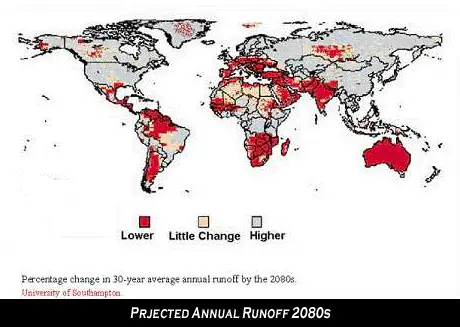Hydrology and Water Resources Management
Currently 1.3 billion people do not have access to adequate supplies of safe water, and 2 billion people do not have access to adequate sanitation. Today, water availability falls below 1,000 m3 per person per year – a common benchmark for water scarcity, and some nineteen countries, primarily in the Middle East and Africa are classified as water-scarce or water-stressed. Even without climate change, this number is expected to double by 2025, in large part because of increases in demand from population and economic growth.
For instance, a report published by the Adelphi Research gGmbH and Germanwatch 2007 documents a judgement delivered in February 2007 in the century-old dispute over the waters of the Cauvery River in southern India. The Cauvery Water Disputes Tribunal laid down the amount of water that each of the riparian states is allowed to withdraw from the river every year. Water scarcity is a recurring phenomenon in the region caused by increasing demand from agriculture, a growing population, urbanisation and industrialisation, coupled with reduced and irregular rainfall. The upper riparian state of Karnataka and the downstream state of Tamil Nadu have therefore been squabbling over the allocation and use of the Cauvery waters for years. An interim order of the Tribunal in 1991 resulted in violent clashes between Tamils and Kannadigas in which over 50 people lost their lives.
It is unfortunate that in many regions of the world a significant fraction of water resources is wasted, largely through inefficient irrigation in the agricultural sector. Higher land temperatures, hence higher crop evaporative demand, mean that the general tendency would be towards an increase in irrigation demands. A change in the volume and distribution of water will affect both ground and surface water supply for domestic and industrial uses, irrigation, hydropower generation, navigation, in stream ecosystems and water based recreation.
Climate change will further exacerbate the frequency and magnitude ofdroughts in some places, in particular central Asia, northern and southernAfrica , the Middle East, the Mediterranean and Australia where droughts are already a recurrent feature. Developing countries are highly vulnerable to climate change and increased water stress because many are located in arid and semi-arid areas. In addition, it should be recognised that the frequency and magnitude of floods in most regions of the world are expected to increase because of the projected increase in heavy rainfall events.

The International Panel on Climate Change (IPCC) propose, “changes in the total amount of precipitation and in its frequency and intensity directly affect the magnitude and timing of runoff and the intensity of floods and droughts. Relatively small changes in temperature and precipitation, together with the nonlinear effects on evapotranspiration and soil moisture, can result in relatively large changes in runoff, especially in arid and semiarid regions. High latitude regions may experience increased runoff due to increased precipitation, whereas runoff may decrease at lower latitudes due to the combined effects of increased evapotranspiration and decreased precipitation.
More intense rainfall would tend to increase runoff and the risk of flooding, although this would depend not only on the change in rainfall but also on catchments physical and biological characteristics. A warmer climate could decrease the proportion of precipitation falling as snow, leading to reductions in spring runoff and increases in winter runoff.
The impacts of climate change will depend on the baseline condition of the water supply system and the ability of water resource managers to respond not only to climate change but also to population growth and changes in demands, technology, and economic, social and legislative conditions. In some cases – particularly in wealthier countries with integrated water management systems – improved management may protect water users from climate change at minimal cost; in many others, however, there could be substantial economic, social and environmental costs, particularly in regions that already are water limited and where there is considerable competition among users. Experts disagree over whether water supply systems will evolve substantially enough in the future to compensate for the anticipated negative impacts of climate change on water resources and for potential increases in demand.
Options for dealing with the possible impacts of a changed climate and increased uncertainty about future supply and demand for freshwater include more efficient management of existing supplies and infrastructure. This will need to include institutional water resource arrangements to limit future demands/promote conservation; improved monitoring and forecasting systems for floods/droughts; rehabilitation of watersheds, especially in the tropics; and construction of new reservoir capacity to capture and store excess flows produced by altered patterns of snow melt and storms.
In an attempt to deliver freshwater to metropolitian areas many countries are investing in desalination plants, and some are also developing solar desalination. See also the sections on measuring water precipitation and measuring water quality.
